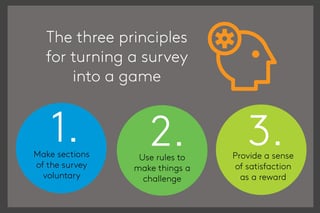Survey design in research is something that has generally evolved rather than proactively developed with questions phrased in the language of research and designed solely to answer the researcher’s query. What we tend to forget is whether anyone actually wants to read that question, let alone whether it’s engaging enough to make someone want to answer it.
Lightspeed Health held a survey design workshop at the 2017 BHBIA Annual Conference where we addressed some of these concerns and looked at possible solutions. Our session was divided into three sections looking at different creative industries and the techniques they apply to keep peoples’ attention. First were advertisers, second were story tellers and third were game designers.
We began by looking at advertising, an industry that has mastered the art of speaking to people both directly and succinctly. Where researchers tend to focus upon details and explanation, advertisers focus on condensing and resonating. They succeed when they catch your eye and quickly deliver their message in a way you can relate to. Imagery is used as a tool of engagement and vast effort is applied in copywriting the communication. They may make things pleasurable or fun, and often encourage you to consume their copy by giving a mental reward for doing so.
If a survey were an advert, however, it would often be a very bad one. One that focuses purely on telling you what it wants and paying no attention to whether you want to consume its message. If we want to be sure people are reading and engaging with our surveys then we can learn a trick or two from the world of advertising.
To begin with, we looked at pitching a survey to a panellist. The introduction is the point at which you have to convince someone that what you want to ask is worth them answering. So why start with a long unappealing list of options, when you could instead intrigue them with an advert for the content within?
The content itself could do with an advertiser’s makeover too. The two key downfalls of surveys are the use of too many words and speaking in researcher language. The first lesson is to only say what you need to, and speak in a language respondents can understand. From there you can get more creative. The workshop showed how copywriting techniques borrowed from advertisers such as adding emotion, putting people in a scene and making questions relatable can help improve survey data.
Survey designers however have a harder task than advertisers, which brings us to the next creative industry we can learn from – story tellers. Unlike an advert, we need to hold people’s attention for periods much longer than a few seconds, so what can we learn from the creators of books and films who hold people’s attention for hours on end?
A good narrative
We discussed how a good narrative is the best way to take people on a journey: a clear beginning, middle and end turns a random set of questions into a clear story people can and want to follow.
One simple narrative trick identified was to use a story to answer a central question. Surveys might not have the luxury of dramatic plot lines, but they do have interesting questions at their very heart. Behind every survey is at least one research question which can easily be employed to fascinate respondents.
A questionnaire about shampoo, for example, can easily be centred on the question “What is the secret of a great shampoo?” With this narrative structure it becomes simple to ask questions about: packaging, smell, features, product usage, branding etc., and with a central question pitched to the respondent they do not feel like a random collection of questions.
Such narratives can be applied to even content traditionally seen as quite dry. By centring the narrative on the question of “How would you invest £1 million in your business?” we have had great success in turning a survey about funding sources for SMEs, from an unengaging repetitive task based survey, to a highly engaging, multiple wave and high cross completion project.
As survey designers, we have a larger challenge than other creative industries to engage and retain our audiences. Unlike story tellers, we not only have to involve people passively, but we have to encourage active participation and interaction. Bringing us to the final part of our workshop, and the question of what can be learned from game designers who encourage this type of interaction.
Turning a task from a burden into a game people enjoy is obviously no easy task. You want your content to encourage participation; however, you don’t want engagement to fit around content in a way that distracts people from the content. Go too far and you can not only bias answers but also encourage speeding and lack of concentration, as people skip through the dry content to get to the fun bits.
Therefore, the aim is to integrate the principles of what makes a task a game into the way you ask your questions. We have identified three main principles for doing this.
1. Make things voluntary
A game can’t be a forced exercise and by that principle there is an argument to say that an engaging survey should not be either. Our research has shown that making sections of surveys voluntary can actually result in more participation. In one exercise, involving the rating of a selection of comments, we took two approaches. One where we force people to rate at least 10 comments, and another where we made the whole section voluntary and let people rate as many as they wish. Changing the process to voluntary, we found the average amount people rated went from 11 to 18. Additionally, 85% of panellists took part in the voluntary process, and there was a strong argument to suggest that the fifteen percent who did not were probably best removed from the dataset as they were not concentrating and simply adding noise to the results.
2. Creating a Challenge
The second principle is to use rules to make things a challenge. Instead of simply asking people to list the brands they are aware of, by asking them to name five or by giving them a time constraint of one minute, we have seen the responses increase. The key to set a target slightly higher than most would reach voluntarily, so that it feels like a challenge. An illustration of this we have tested was instead of asking people to “List their favourite shops,” we asked, “Imagine you could design your perfect shopping centre with the shops you liked most. What shops would you have in it?“ This extra constraint and challenge achieved an increase in the amount of shops entered from on average five to 13.
3. Establish Rewards
The final principle to consider is the idea of a reward. Games reward participation, but again we need to take care to clarify what we mean when we advocate rewards. These do not need to be tangible rewards. Incentivising is a double edged sword, while it might encourage participation, it might also encourage participation purely for the reward in a way that is detrimental to engagement.
Learning something new, solving a puzzle or being entertained – all these things can be a reward for individuals taking a survey. One of the easiest and most effective rewards can be putting feedback in a survey.
We have seen that simply by letting people know what other people have answered and how they compare, we get a much better response. In one experiment we used feedback to get our respondents to take 21% longer deliberating their answers and saw an overall increase in deviation as a result, as the noise of disengaged answering was removed from the data set.
The other application of feedback is in longitudinal research. Learning about the previous survey and the progress of a research project is a strong incentive for a panellist to return to subsequent waves of research and we consistently see its effectiveness for ensuring extremely high cross completion rates.
The purpose of our workshop was not necessarily to give a toolset for designing better surveys, but instead to change the mind-set of how to ask questions. By thinking more about how to engage people, rather than just what we want to know, researchers will move away from treating panellists simply as units of information. We need to view our respondents as a network with a potential for problem solving; and a network of thought and data. Because the alternative of taking for granted their responses, and viewing them as an automated input, is unfortunately a sure fire way of ensuring poor data and weak insight.




